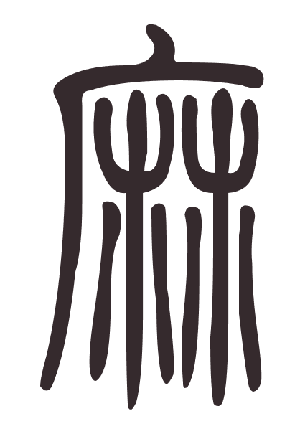(má, hemp, in zhuan script)
In his short essay Li puts forward a number of arguments about the role of cultural techniques in the formation of Chinese culture and the unfolding of China's entrance into the Modern era. The essay opens with a discussion of textile fibers as defining features of ancient Old World cultures: the Mediterranean region cultivated linen, there was cotton culture in India, and in East Asia there was hemp culture (293). The casual reader might be surprised that East Asia is not marked as a silk culture, but Li tells us that from the earliest times the cultivated fields were referred to as “land of mulberry [which attracted silk worms] and hemp.” Hemp was a crucial element in observing ritual propriety (li 禮) since before the days of Confucius. According to the Liji 禮記 one must wear rough hempen clothing during the mourning of one's parents. for example. Confucius states in the Analects 論語 (9.3) that “The use of the hemp cap (麻冕) is prescribed in observance of ritual propriety li 禮. Today people use silk as a matter of frugality. I would follow accepted practice on this.”
You'll note that Li relies upon the first translation of Zhongyong that the Protestant missionary James Legge created, “Doctrine of the Mean.” Twelve years later Legge would later abandon that translation in favor of “The state of equilibrium and harmony.” There's no question that those in power throughout China's history have been influenced by the Zhongyong as all bureaucrats were required to memorize the text as part of their standard exams. But how do we understand the text? Although I disagree with Li that the Zhongyong is primarily a text about moderating one's behavior (a la Aristotle's Golden Mean), I am intrigued by the reading of the Zhongyong as a user's manual. Translating the work is difficult in part because it is straightforward in what it says, but philosophically it appears incoherent at first.
(má, hemp, in contemporary hanzi)
I've argued elsewhere (Boshears, Boeri, Harbry 2011; Boshears 2012; Boeri, Gibson, Boshears 2014) that addiction is a networked phenomenon: one is apprenticed into addiction and out of addiction. In so far as "addiction" as a concept is philosophically coherent it is a description of learned technological relating that has gone askew. In my dissertation I will consider drug use from the perspective of cultural techniques and as a case study I will examine how addiction came to be articulated by colonial European agents acting in China. The creation of the concept of addiction was a means of naturalizing colonial Europe's cultural techniques and providing a pretext for further subjugating non-Europeans. I suspect that unpacking the Zhongyong's position on education will help us understand what is possible in pedagogy and contribute a novel interpretation of how addiction "happens."







I am so pleased I found this blog, I really got you by an accident, while I was searching for something else. The story and blog you have published is very interesting as well as informatics, Thanks for sharing such type of informatics thing.
ReplyDeleteHere is some useful information too
DRU Fires
Gazco Gas Fire
Zehnder Designer Radiators
Reina Designer Radiators
Bosch Home Appliances
Franke Kitchen Sinks
Neff Kitchen Appliances
Aeon Designer Radiators
Bisque Designer Radiators
Manhattan Shower Enclosures
Blanco Kitchen Appliances
Matki Bathrooms
Royce Morgan Baths
HIB Quality Bathroom Products
Hudson Reed Bathrooms
Premier Baths
Vitra Baths
Phoenix Baths
RAK Ceramics
Hansgrohe Baths
Roca Baths
This comment has been removed by the author.
ReplyDeleteDescription: Le Bye Bra est une solution simple pour améliorer rapidement et efficacement la poitrine de la femme sans avoir besoin
ReplyDeleted’une intervention chirurgicale ou même d’un soutien-gorge!
soutiens-gorge adhésif
Pakistan News
ReplyDelete